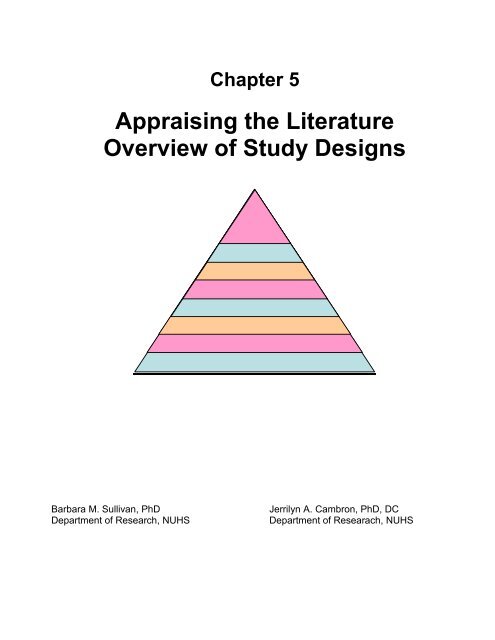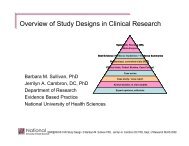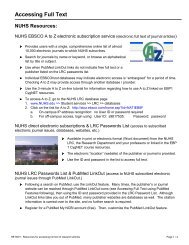Appraising the Literature Overview of Study Designs
Appraising the Literature Overview of Study Designs
Appraising the Literature Overview of Study Designs
Create successful ePaper yourself
Turn your PDF publications into a flip-book with our unique Google optimized e-Paper software.
Chapter 5<br />
<strong>Appraising</strong> <strong>the</strong> <strong>Literature</strong><br />
<strong>Overview</strong> <strong>of</strong> <strong>Study</strong> <strong>Designs</strong><br />
Barbara M. Sullivan, PhD<br />
Department <strong>of</strong> Research, NUHS<br />
Jerrilyn A. Cambron, PhD, DC<br />
Department <strong>of</strong> Researach, NUHS
EBP@NUHS Ch 5 - <strong>Overview</strong> <strong>of</strong> <strong>Study</strong> <strong>Designs</strong> Sullivan BM, Cambron JA 2008 3
<strong>Overview</strong> <strong>of</strong> Clinical Research <strong>Study</strong> <strong>Designs</strong><br />
Randomized, controlled trials (RCT)<br />
Experimental<br />
Considered <strong>the</strong> “Gold Standard” for <strong>the</strong>rapy studies<br />
Researcher manipulates <strong>the</strong> intervention or exposure (independent variable)<br />
and records effect on outcome <strong>of</strong> interest (dependent variable)<br />
Participants are randomly allocated into intervention (treatment) and control<br />
(comparison, placebo) groups<br />
Randomization (if done) method is key to RCT; not always done = “clinical trial”<br />
o “Controlled clinical trial” or “clinical trial” designs may have limited or no<br />
randomization<br />
o Eliminates bias (hopefully)<br />
Random allocation vs. random selection (for surveys)<br />
o Random allocation: Subjects chosen for a research study are randomly placed (allocated) into one<br />
study group (intervention) or ano<strong>the</strong>r (control, comparison, placebo)<br />
− Investigators usually define initial inclusion characteristics – define why certain subjects are<br />
included or excluded from <strong>the</strong> study overall<br />
o Random selection: People are randomly chosen (selected) from a group (population) to be in a<br />
research study<br />
o May not define specific inclusion criteria<br />
o Hidden bias introduced through imperfect randomization, failure to randomize all eligible patients,<br />
failure to blind assessors to patients’ randomization<br />
Groups receiving intervention(s) or control (comparison or placebo <strong>the</strong>rapy) are identical (on average) with<br />
<strong>the</strong> exception <strong>of</strong> <strong>the</strong> intervention received. Differences in outcomes are attributable to <strong>the</strong> intervention only.<br />
Strengths<br />
Strongest study design because <strong>the</strong>re is so much control over <strong>the</strong> study<br />
Investigators control <strong>the</strong> intervention<br />
Allows rigorous evaluation <strong>of</strong> a single variable<br />
Prospective: data is collected after <strong>the</strong> study is designed and in progress<br />
Seeks to falsify (not confirm) its own hypo<strong>the</strong>sis<br />
Seeks to eradicate bias through comparison and blinding<br />
Randomization decreases bias in group placement<br />
Blinding <strong>of</strong> investigators to outcome measures decreases bias<br />
o Blinding more likely<br />
Unbiased distribution <strong>of</strong> confounders: 2 or more factors that are “associated” (age and weight) and may<br />
affect (confuse, distort) <strong>the</strong> effect <strong>of</strong> <strong>the</strong> o<strong>the</strong>r(s) on <strong>the</strong> outcome (onset <strong>of</strong> diabetes)<br />
Very structured <strong>the</strong>rapy or intervention can be accurately described<br />
Randomisation facilitates statistical analysis<br />
o Allows for “meta-analysis” (combining numerical results) at a later date.<br />
Limitations<br />
Expensive and time consuming<br />
o Takes many research personnel to complete<br />
May have limited applicability to a general population or a practice population due to tight inclusion and<br />
exclusion criteria<br />
True randomization is difficult to achieve<br />
o Incomplete randomization<br />
o Volunteer bias<br />
Bias in selection and randomization<br />
Often impractical<br />
o Structured “design,” intervention, environment may be different than results a clinician would get in<br />
private (“real world”) practice<br />
o No variation from <strong>the</strong> intervention can be made by <strong>the</strong> research clinician<br />
Ethically problematic at times<br />
o O<strong>the</strong>r study designs may be more appropriate<br />
EBP@NUHS Ch 5 - <strong>Overview</strong> <strong>of</strong> <strong>Study</strong> <strong>Designs</strong> Sullivan BM, Cambron JA 2008 4
Case-control studies<br />
Observational<br />
Focus on <strong>the</strong> etiology <strong>of</strong> a disease or health issue<br />
Patients with a particular health concern / characteristic / disease<br />
Matched with “controls:”<br />
Identical patients without that issue<br />
Identical patients with a different disease<br />
<br />
<br />
General population<br />
Cases (with disease) vs. Controls (without disease) must be well-defined<br />
and adequately described<br />
Cases and controls should be taken from <strong>the</strong> same general population at<br />
risk <strong>of</strong> developing <strong>the</strong> disease, but with differing exposure to <strong>the</strong> potential<br />
risk factor. (minimizes selection bias)<br />
<br />
<br />
<br />
Cases and controls should have <strong>the</strong> same opportunity to be exposed or receive <strong>the</strong> exposure.<br />
Matching case and controls is one <strong>of</strong> <strong>the</strong> major challenges <strong>of</strong> this study design<br />
Matching should go beyond demographics if o<strong>the</strong>r factors are known to be important for or affect <strong>the</strong><br />
disease (e.g., general condition <strong>of</strong> health, ability to function, seek health care, etc.)<br />
Can choose multiple control groups or multiple controls for each case); avoids selection bias (comparing<br />
2 groups <strong>of</strong> patients who differ in more aspects that <strong>the</strong> one under study and one or more <strong>of</strong> those o<strong>the</strong>r<br />
aspects affect <strong>the</strong> outcome <strong>of</strong> <strong>the</strong> disease)<br />
Retrospective: look backwards in time<br />
Data <strong>of</strong>ten is collected by searching through patient histories or through patient recall surveys<br />
Compare past histories <strong>of</strong> possible risk factors between cases and controls<br />
Best if <strong>the</strong> study involves new (incident) cases (less problems with history, recall)<br />
Used to study rare conditions (strong study design)<br />
Used to study <strong>the</strong> relative risk <strong>of</strong> disease related to a particular characteristic (genetic factor, exposure)<br />
Can be used to look at multiple factors or exposures for disease<br />
Validity depends on <strong>the</strong> ability to compare <strong>the</strong> case and controls<br />
Strengths:<br />
Quick and not as complicated, expensive as RCT; short time required to conduct<br />
Investigators can identify cases unconstrained by <strong>the</strong> natural frequency <strong>of</strong> <strong>the</strong> disease and are able to<br />
make comparisons<br />
Only feasible method for very rare disorders or those with long lag between exposure and outcome<br />
(strong study design for rare diseases or diseases with a long latency)<br />
Fewer subjects needed than cross-sectional or cohort studies<br />
No additional risks to subjects (experimental interventions)<br />
Existing records can be used (hospital records; health registries)<br />
Can be used to study multiple factors affecting one outcome (disease)<br />
Limitations:<br />
Case selection must be very well-defined (when is a “case” a “case”)<br />
Matching should go beyond demographics if o<strong>the</strong>r factors are known to be important for or affect <strong>the</strong><br />
disease (e.g., general condition <strong>of</strong> health, ability to function, seek health care, etc.)<br />
Selection <strong>of</strong> control groups is difficult: people at risk <strong>of</strong> getting disease, but do not have <strong>the</strong> disease<br />
o Confounders: 2 or more factors that are “associated” (age and weight) and may affect (confuse,<br />
distort) <strong>the</strong> effect <strong>of</strong> <strong>the</strong> o<strong>the</strong>r(s) on <strong>the</strong> outcome (onset <strong>of</strong> diabetes)<br />
Selection bias: investigators “create” <strong>the</strong> comparison groups ra<strong>the</strong>r than “letting nature take its course” in<br />
determining who in <strong>the</strong> population becomes a “case” and who remains a control.<br />
o Controls are not a “naturally occurring” group<br />
o Patients may differ in additional factors or aspects not under study that may affect <strong>the</strong> outcome <strong>of</strong><br />
<strong>the</strong> disease<br />
Measurement bias: exposure is measured after <strong>the</strong> onset <strong>of</strong> <strong>the</strong> disease or outcome under study;<br />
presence <strong>of</strong> outcome directly affects <strong>the</strong> exposure, affects subject’s recall <strong>of</strong> exposure or affects<br />
measurement or recording <strong>of</strong> <strong>the</strong> exposure.<br />
Recall bias: Reliance on recall or records to determine exposure status (retrospective study)<br />
Can only be used to study one outcome (disease)<br />
EBP@NUHS Ch 5 - <strong>Overview</strong> <strong>of</strong> <strong>Study</strong> <strong>Designs</strong> Sullivan BM, Cambron JA 2008 5
Cohort Studies<br />
Observational<br />
No randomization<br />
No control over intervention or risk factor exposure (researcher observes subjects but does not<br />
control exposure)<br />
Provide a direct estimate <strong>of</strong> absolute risk: <strong>the</strong> probability <strong>of</strong> developing disease during a given time<br />
period<br />
Patients with similar characteristics at a common point in <strong>the</strong> course <strong>of</strong> <strong>the</strong> disease or health issue<br />
and followed over time using pre-defined measures <strong>of</strong> outcomes (pain, function, activities/quality <strong>of</strong><br />
life, satisfaction with care, etc.)<br />
Prospective: follow groups forward in time from exposure to defined outcome <strong>of</strong> interest (disease)<br />
Measurement <strong>of</strong> <strong>the</strong> same outcome / issue<br />
Patients suffering from low back pain<br />
Death from heart attack<br />
Subjects can be matched<br />
Two groups <strong>of</strong> patients differ in one characteristic<br />
For example, smokers or non-smokers<br />
Non-random allocation into one group or ano<strong>the</strong>r (exposed / not exposed)<br />
Comparison group<br />
Eligibility criteria and outcome assessments can be standardized<br />
The best way to identify this study design:<br />
Incidence rates defined<br />
Natural history <strong>of</strong> disease is discussed<br />
Strengths:<br />
Ethically safe;<br />
Subjects can be matched; comparison group<br />
Can establish timing and directionality <strong>of</strong> events<br />
Eligibility criteria and outcome assessments can be standardized;<br />
Administratively easier, less expensive, less complicated than RCT.<br />
Limitations:<br />
Controls may be difficult to identify<br />
Exposure may be linked to a hidden confounder;<br />
Blinding is difficult<br />
No randomization<br />
Large sample sizes or long follow-up is necessary for rare disease<br />
o The expense and logistics associated with <strong>the</strong> attempt to compare <strong>the</strong> natural frequency <strong>of</strong><br />
a potential disease associated with a particular exposure may not be feasible. A casecontrol<br />
study (fewer subjects needed) may be more appropriate.<br />
O<strong>the</strong>r names for Cohort Studies<br />
Incidence study<br />
Longitudinal study<br />
Forward-looking study<br />
Follow-up study<br />
Concurrent study<br />
Prospective study<br />
EBP@NUHS Ch 5 - <strong>Overview</strong> <strong>of</strong> <strong>Study</strong> <strong>Designs</strong> Sullivan BM, Cambron JA 2008 6
Case series<br />
Description <strong>of</strong> one group <strong>of</strong> patients (generally 10 or more) with similar diagnoses or <strong>the</strong>rapy followed<br />
over time<br />
Descriptive study; does not test <strong>the</strong> hypo<strong>the</strong>sis <strong>of</strong> treatment efficacy<br />
Should not be used for comparison <strong>of</strong> treatments<br />
Should have:<br />
Clearly defined question<br />
Well-defined, detailed case definition<br />
Very well-defined population involved in <strong>the</strong> study<br />
Well-defined, well-described intervention, easily followed, replicated<br />
Use <strong>of</strong> standardized descriptors, criteria and data<br />
Use <strong>of</strong> validated outcome measures<br />
<br />
<br />
Clear presentation <strong>of</strong> data and results<br />
Appropriate statistical analyses<br />
o Larger number <strong>of</strong> cases (than a case study) allows statistical analysis (p values, means,<br />
standard deviations)<br />
Well-described results focused on outcome measurement<br />
Discussion and conclusions supported by data presented<br />
Funding sources, affiliations acknowledged<br />
IRB, human subjects review<br />
Multiple uses:<br />
Case definition & detailed descriptors<br />
o Useful as a “benchmarking” descriptive study<br />
Initial reports <strong>of</strong> new diagnosis or innovative treatment<br />
Description <strong>of</strong> <strong>the</strong> natural history or natural progression <strong>of</strong> a condition or disease, recovery,<br />
complication rates<br />
Trend analyses, descriptors, registry data <strong>of</strong> outcomes<br />
Healthcare planning including economic analysis<br />
Hypo<strong>the</strong>sis, analysis <strong>of</strong> causation<br />
o Can be a hypo<strong>the</strong>sis generating study, basis <strong>of</strong> follow-up studies<br />
Multi-institutional registry<br />
All subjects receive same treatment<br />
Treatment or intervention should be well described<br />
No comparison group<br />
If inclusion and exclusion data were used, explicit definitions and descriptions should be provided<br />
Larger number <strong>of</strong> cases (than a case study) allows statistical analysis (p values, means, standard<br />
deviations)<br />
Allows determination <strong>of</strong> role <strong>of</strong> chance (as opposed to single case study)<br />
Often retrospective (look back in time) restricting value as prognosis study or determining cause and<br />
effect relationships<br />
<br />
Prospective (looking forward) studies are <strong>of</strong>ten designed as prospective cohort studies, including a<br />
control group (a benefit, strength).<br />
<br />
Strengths:<br />
Clearly defined question<br />
Clearly defined study population<br />
Well described study intervention<br />
Outcome measures should be well-defined and validated<br />
Well-described results supported by data and well-defined<br />
observations<br />
Use <strong>of</strong> statistical analysis to assess <strong>the</strong> role <strong>of</strong> chance<br />
EBP@NUHS Ch 5 - <strong>Overview</strong> <strong>of</strong> <strong>Study</strong> <strong>Designs</strong> Sullivan BM, Cambron JA 2008 7
Case series (con’t)<br />
Limitations:<br />
No comparison group<br />
Blinding is unlikely<br />
Cannot be used to draw inferences regarding efficacy<br />
Not strong enough (typically) to test a hypo<strong>the</strong>sis<br />
Published “benchmarking” studies usually are those with <strong>the</strong> best outcomes<br />
<strong>Study</strong> population may not be representative; generalization may be difficult<br />
o <strong>Study</strong> population may be too narrow to generalize to a different age, sex, culture, etc.<br />
o “Mixed” population may require larger sample sizes to realize trends in outcomes<br />
________________________________________________________________________________<br />
Case report / case study<br />
Detailed description a single case<br />
Describe rare events or early trends<br />
Elucidate mechanisms <strong>of</strong> a disease or health issue and treatment<br />
Describe unusual manifestations <strong>of</strong> a disease or health issue; describe an unusual response to an<br />
exposure or intervention<br />
Highly detailed and methodologically sophisticated clinical and laboratory studies <strong>of</strong> a patient (small<br />
group <strong>of</strong> patients = case series)<br />
Rich source <strong>of</strong> ideas, hypo<strong>the</strong>ses about disease, conditions, risk, prognosis and treatment.<br />
Not typically useful or strong enough to test a hypo<strong>the</strong>sis<br />
Initiate issues and trigger more decisive studies<br />
Should have a very detailed, well-defined description <strong>of</strong> <strong>the</strong> patient<br />
Do not include a statistical analysis; <strong>the</strong>refore, a determination <strong>of</strong> “chance” cannot be made<br />
Strengths:<br />
Use as a “signal” to look for (or devise) fur<strong>the</strong>r studies and evidence <strong>of</strong> <strong>the</strong> described<br />
phenomenon<br />
All subjects receive treatment (at least some <strong>of</strong> <strong>the</strong> time)<br />
Statistical tests assuming randomization can be used<br />
Blinding can be maintained<br />
Limitations:<br />
Particularly susceptible to bias<br />
Not able to test most hypo<strong>the</strong>ses<br />
Reports <strong>of</strong> successful <strong>the</strong>rapy may be misleading since journals<br />
rarely print “negative” or unsuccessful case studies.<br />
Cannot be used to estimate <strong>the</strong> frequency <strong>of</strong> <strong>the</strong> described event<br />
(positive reaction <strong>of</strong> an intervention), role <strong>of</strong> bias or chance<br />
o Does not include a statistical analysis; <strong>the</strong>refore, a<br />
determination <strong>of</strong> “chance” cannot be made.<br />
EBP@NUHS Ch 5 - <strong>Overview</strong> <strong>of</strong> <strong>Study</strong> <strong>Designs</strong> Sullivan BM, Cambron JA 2008 8
Cross-sectional surveys<br />
Representative sample <strong>of</strong> subjects or patients<br />
Interview, survey, study<br />
Data is collected at a single time point<br />
Data collection may depend on history or recall<br />
Establishes association, not causality<br />
Often used to develop fur<strong>the</strong>r clinical research<br />
Strengths:<br />
Less expensive and administratively simple<br />
Ethically safe<br />
Limitations:<br />
Establishes association at most, not causality<br />
Recall bias susceptibility<br />
Confounders (2 or more factors that are “associated” (age and weight) and may affect (confuse,<br />
distort) <strong>the</strong> effect <strong>of</strong> <strong>the</strong> o<strong>the</strong>r(s) on <strong>the</strong> outcome (onset <strong>of</strong> diabetes)<br />
Neyman’s bias (incidence – prevalence bias or selective survival bias)<br />
Group sizes may be unequal.<br />
Cross-over Design<br />
Subjects are “moved” to <strong>the</strong> alternative group (intentional)<br />
“Control” or placebo group receives treatment<br />
Treatment group receives placebo or control treatment<br />
Intentional cross-over (by design) allows subjects to serve as <strong>the</strong>ir own<br />
control or placebo group.<br />
Sample size is reduced (no need for an “equal set” <strong>of</strong> <strong>the</strong> control<br />
or treatment groups<br />
Error variance (statistical analysis) is reduced<br />
Unintentional cross-over between study groups (treatments and control) is <strong>of</strong>ten allowed for ethical<br />
reasons. However, studies should take into consideration <strong>the</strong> possibility <strong>of</strong> unintended cross-overs<br />
and allow for <strong>the</strong> possibility in <strong>the</strong> calculation <strong>of</strong> how many subjects are needed in a study.<br />
Strengths:<br />
Intentional cross-over design is a very strong design, reducing variance among and<br />
between groups<br />
<br />
<br />
<br />
All subjects receive treatment (at some point during <strong>the</strong> study)<br />
Statistical tests assuming randomization can be used<br />
Blinding can be maintained<br />
Limitations:<br />
All subjects receive placebo or alternative treatment at some point<br />
Washout period (treatment effect diminishes or ends) lengthy or unknown<br />
Cannot be used for treatments with if <strong>the</strong> <strong>the</strong>rapy (or control, comparison, placebo <strong>the</strong>rapy) has<br />
permanent effects (subjects cannot “cross-over”)<br />
Unintended cross-over (allowed for ethical reasons and patient preference) should be<br />
accounted for in calculations for <strong>the</strong> number <strong>of</strong> subjects needed for <strong>the</strong> study<br />
EBP@NUHS Ch 5 - <strong>Overview</strong> <strong>of</strong> <strong>Study</strong> <strong>Designs</strong> Sullivan BM, Cambron JA 2008 9
Hierarchy <strong>of</strong> <strong>Study</strong> <strong>Designs</strong><br />
“Level” <strong>of</strong> evidence<br />
1a<br />
Systematic Reviews (SR),<br />
Meta-Analysis<br />
Best Evidence / Evidence Guidelines & Summaries<br />
2a<br />
1b<br />
Randomized, controlled trials (RCT)<br />
Clinical trials, Cohort Studies<br />
2b<br />
6<br />
5<br />
4<br />
3a<br />
Case Control, Case series<br />
Case study / case report<br />
Animal studies, in vitro studies<br />
Expert opinions, editorials, ideas<br />
3b<br />
References:<br />
Center for Evidence Based Medicine www.cebm.net EBM Tools: <strong>Study</strong> Design accessed December<br />
12, 2007.<br />
Fletcher RH, Fletcher SW, Wagner EH. Clinical Epidemiology, 3 rd edition. Baltimore, MD: Williams &<br />
Wilkins 1996.<br />
Greenhalgh T How to read a paper: <strong>the</strong> basics <strong>of</strong> evidence-based medicine (2 nd Ed). London: BMJ<br />
Books, 2001.<br />
Strauss SE, Richardson W S, Glasziou P, Haynes RB. Evidence-based Medicine: How to practice and<br />
teach EBM (3rd ed.). Edinburgh New York: Elsevier/Churchill Livingstone, 2005.<br />
West S, King V, Carey TS, et al. Systems to rate <strong>the</strong> strength <strong>of</strong> scientific evidence. File Inventory,<br />
Evidence Report/Technology Assessment Number 47. AHRQ Publication No. 02-E0106, April<br />
2002. Agency for Healthcare Research and Quality, Rockville, MD. Available at<br />
http://www.ahrq.gov/clinic/strevinv.htm<br />
EBP@NUHS Ch 5 - <strong>Overview</strong> <strong>of</strong> <strong>Study</strong> <strong>Designs</strong> Sullivan BM, Cambron JA 2008 10





